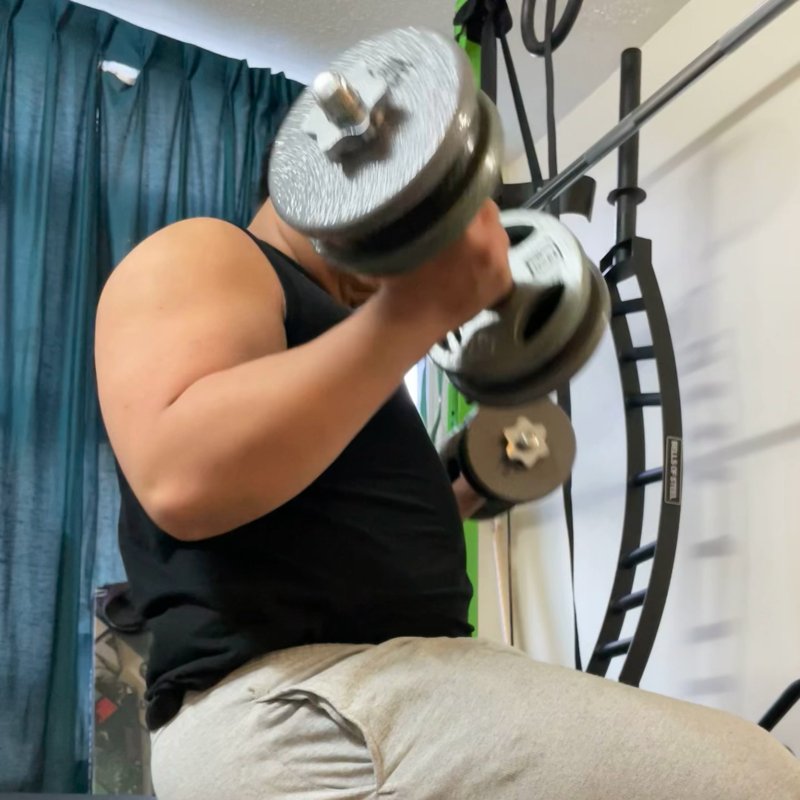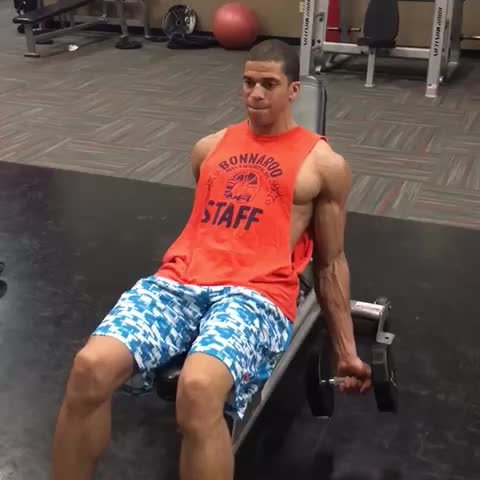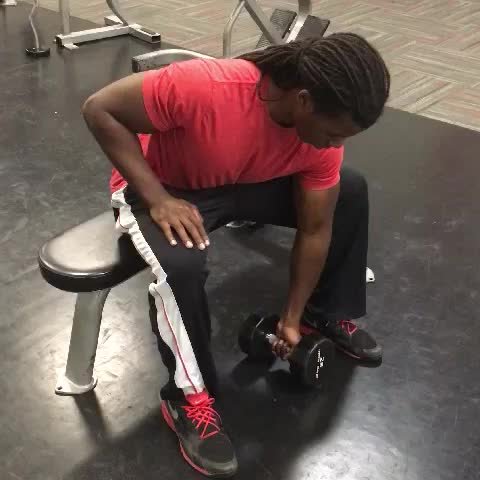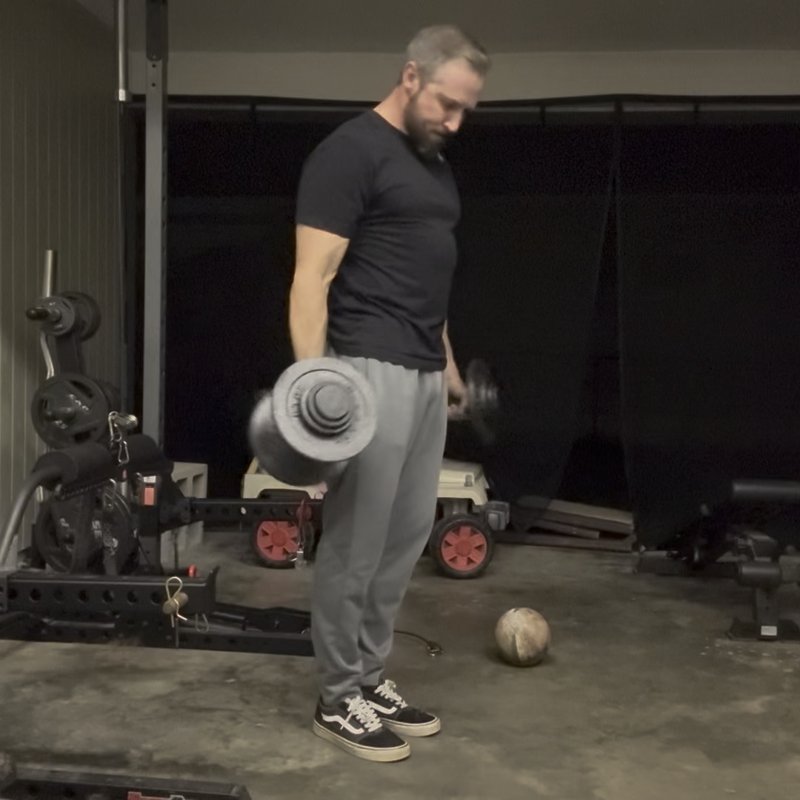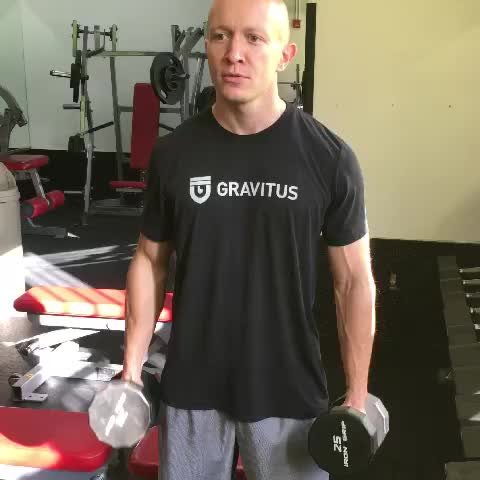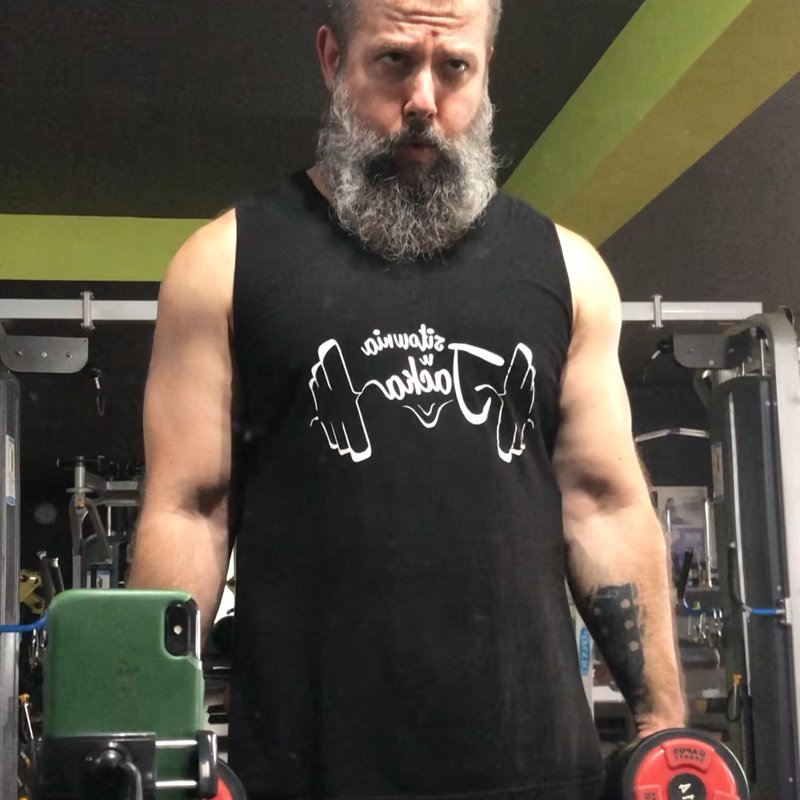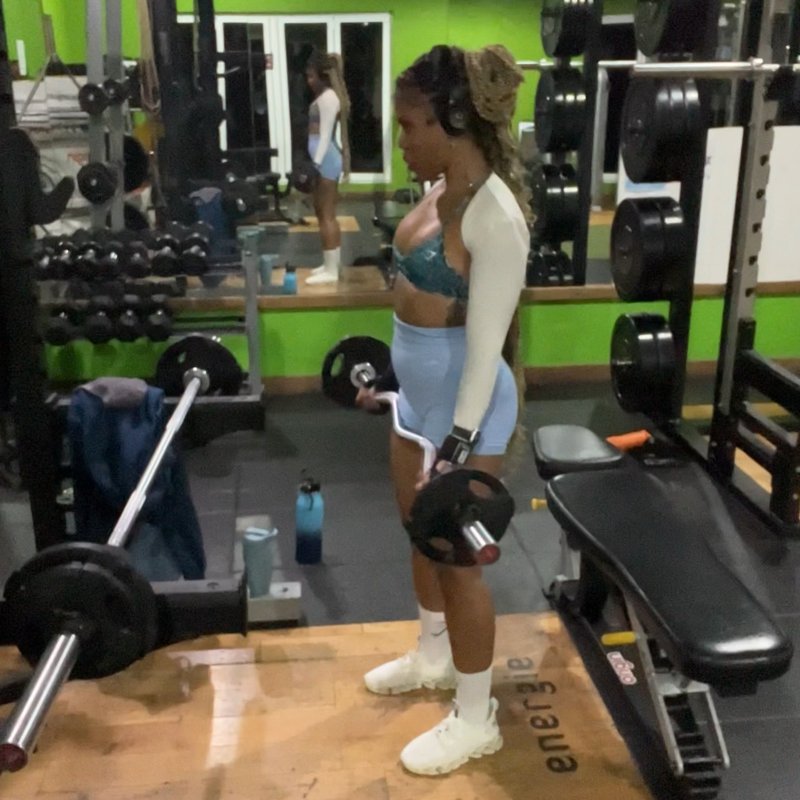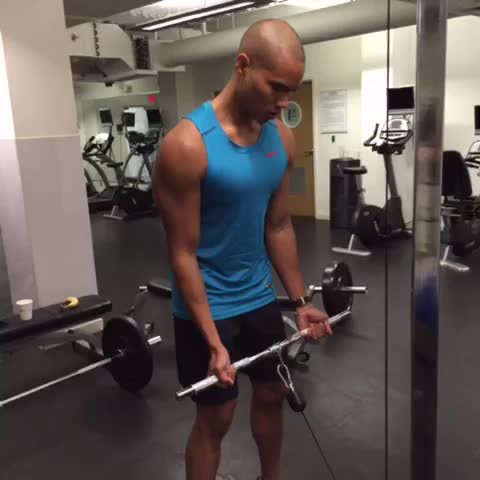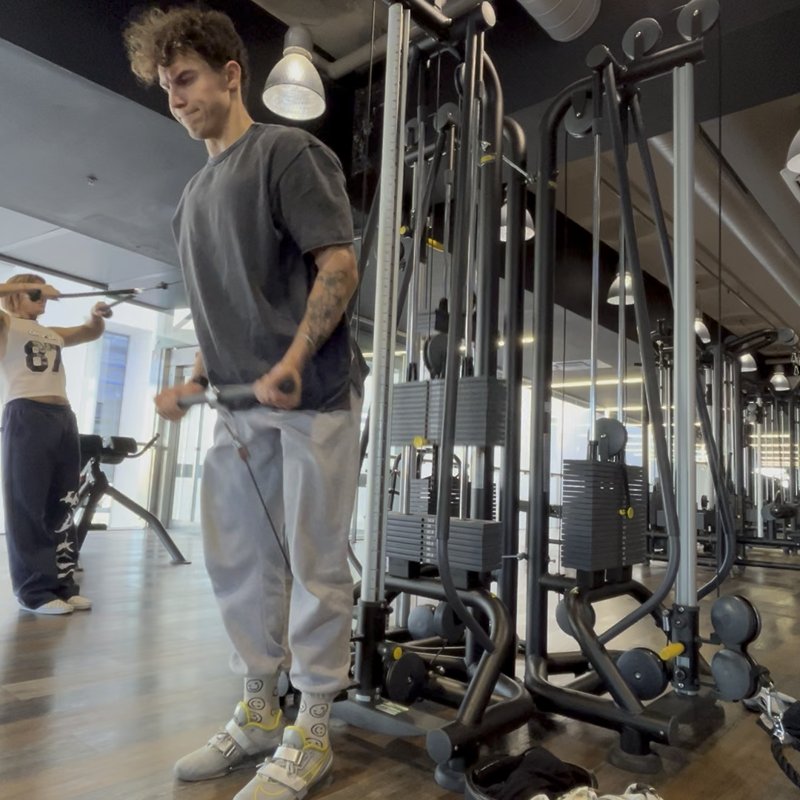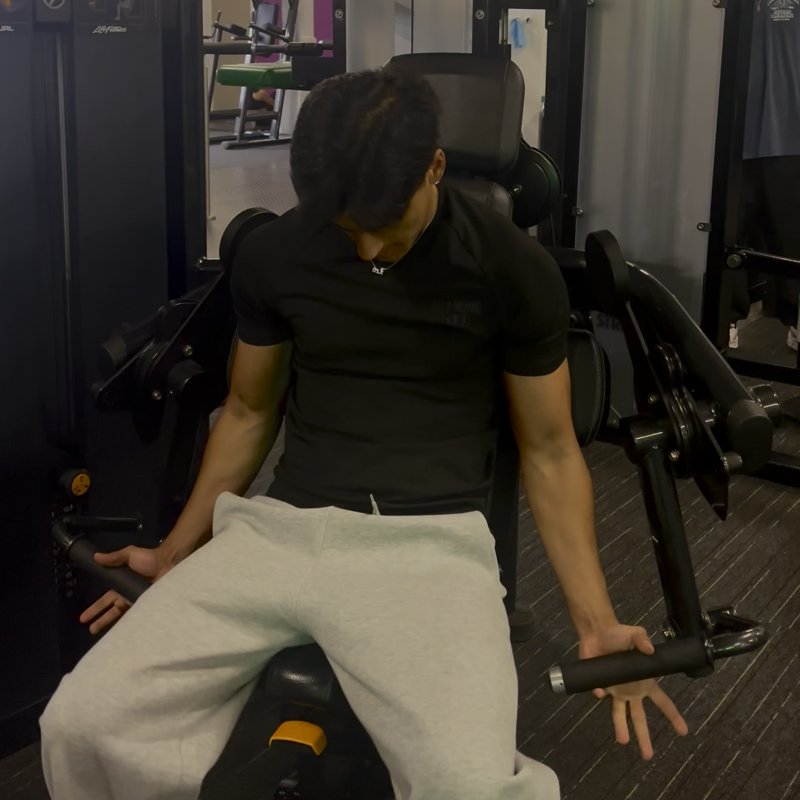Dumbbell Curl: The Ultimate Guide
The dumbbell curl is a fundamental isolation exercise that directly targets the biceps muscles. This guide covers proper technique, variations, and programming strategies for optimal bicep development and arm strength.

Quick Facts
Key Benefit
Directly targets the biceps brachii for maximum arm definition and peak development
Primary Muscles
Biceps, Brachialis
Secondary Muscles
Anterior Deltoids, Forearms, Traps
Equipment
Dumbbells
Difficulty
Beginner
Type
Isolation, Hypertrophy
In This Guide
Ready to master the Dumbbell Curl?
Track your progress, see improvements over time, and build strength consistently.
Download GravitusThe Dumbbell Curl is one of the most effective exercises for developing the biceps brachii muscles. This fundamental isolation movement has been a staple in arm training for decades and remains popular for good reason—it directly targets the biceps with excellent muscle activation while allowing for natural movement patterns that accommodate individual biomechanics. Unlike barbell variations, dumbbells enable each arm to move independently, allowing for a more natural curling arc and helping identify and correct strength imbalances between sides. The dumbbell curl also permits rotation of the wrist during the movement (supination), which enhances the recruitment of the biceps brachii, particularly the long head that contributes to the coveted bicep peak. While often considered primarily an aesthetic exercise, strong biceps serve important functional purposes as well. As one of the primary elbow flexors, the biceps are involved in countless pulling movements in both daily activities and athletic endeavors. Additionally, the biceps brachii crosses the shoulder joint and assists with certain shoulder movements, making its development relevant to overall upper body function. Whether you're looking to build impressive arms, increase functional pulling strength, or simply add an effective exercise to your routine, the dumbbell curl is an excellent choice. This comprehensive guide covers proper technique, common mistakes to avoid, effective variations, and programming strategies to help you maximize your results with this classic exercise.
Why the Dumbbell Curl Is Worth Mastering
The dumbbell curl offers several distinct advantages that make it a valuable addition to any arm training program:
Targeted Bicep Development
Directly isolates the biceps brachii with minimal assistance from other muscle groups, making it highly effective for building bicep size and definition.
Balanced Strength Development
Working each arm independently helps identify and address strength imbalances between sides, promoting balanced muscular development.
Natural Movement Pattern
Allows each arm to follow its most comfortable and natural curling path, accommodating individual biomechanics and potentially reducing joint stress.
Proper Dumbbell Curl Form: Step-by-Step
Starting Position
- Stand with feet shoulder-width apart, maintaining good posture with chest up and shoulders back.
- Hold a dumbbell in each hand with arms fully extended at your sides.
- Begin with a neutral grip (palms facing your body) or a slightly supinated grip (palms angled slightly forward).
- Keep elbows close to your sides and locked in this position throughout the movement.
- Engage your core slightly to maintain stability and prevent swaying.
The Movement
- Keeping your upper arms stationary against your sides, exhale as you curl the weights upward by flexing at the elbow.
- As you curl, gradually rotate your wrists so that the palms face upward (supination) by the time you reach the halfway point.
- Continue curling until the dumbbells reach shoulder level, with biceps fully contracted.
- At the top position, focus on squeezing your biceps for a brief moment to maximize contraction.
- Inhale as you slowly lower the weights back to the starting position, controlling the descent and gradually rotating your wrists back to the starting position.
- Fully extend your arms at the bottom without locking your elbows, maintaining tension on the biceps.
- Repeat for the desired number of repetitions, maintaining strict form throughout the set.
Key Form Tips
Elbow Position
Keep elbows pinned to your sides throughout the movement to isolate the biceps and reduce shoulder involvement.
Wrist Rotation
Incorporate a natural supination (rotating from neutral to palms-up) during the curl to maximize biceps recruitment.
Controlled Movement
Avoid using momentum or "swinging" the weights up; focus on muscular contraction, not weight moved.
Full Range of Motion
Allow complete extension at the bottom (without locking elbows) and full flexion at the top for optimal development.
Tempo Control
Consider using a slower eccentric (lowering) phase of 2-3 seconds to increase time under tension.
Mental Connection
Focus on feeling the biceps working throughout the entire movement, particularly at the peak contraction.
Muscles Worked in the Dumbbell Curl
Primary Muscles
- biceps: The two-headed muscle at the front of the upper arm, responsible for elbow flexion and forearm supination, is the primary target of this exercise.
- brachialis: Located beneath the biceps brachii, this muscle contributes to elbow flexion and is engaged particularly in the early to mid-range of the curl.
Secondary Muscles
- brachioradialis: A muscle of the forearm that assists with elbow flexion, especially in the neutral grip position at the beginning of the curl.
- forearms: The various muscles of the anterior forearm that flex the wrist and fingers are engaged as stabilizers during the exercise.
- anterior deltoids: The front shoulder muscle provides minimal assistance during the initial phase of the curl, particularly if strict form is not maintained.
- traps: Can become involved if shrugging occurs during the movement, though this should be minimized for proper isolation.
Common Mistakes and How to Avoid Them
Using excessive body momentum
Swinging the body to help lift the weight reduces bicep activation and increases injury risk. Keep your torso stable and upright throughout the movement, focusing on moving only at the elbow joint. If you can't curl the weight without swinging, it's too heavy. Lower the weight and focus on proper form with strict muscle isolation.
Moving the elbows forward or outward
Allowing the elbows to come forward or flare outward turns the movement into a front raise or hybrid exercise that reduces bicep isolation. Keep your elbows pinned against your sides throughout the entire exercise, creating a fixed pivot point for the curling motion.
Incomplete range of motion
Not lowering the weights fully or not curling them high enough reduces the effectiveness of the exercise. Use a complete range of motion from full extension (without completely locking the elbows) to complete flexion, with the dumbbells reaching approximately shoulder height at the top of the movement.
Excessive wrist flexion/extension
Allowing the wrists to bend significantly during the curl reduces force transfer to the biceps and can cause wrist strain. Maintain relatively neutral wrists throughout the movement, focusing on supination (rotation) rather than flexion or extension.
Dumbbell Curl Variations
Body Position Variations
-
Seated Dumbbell Curl
Performing the movement while seated eliminates the potential to use lower body momentum, ensuring strict form and greater isolation of the biceps.
-
Incline Dumbbell Curl
Executed while lying back on an inclined bench, this variation increases the stretch at the bottom position and places greater emphasis on the long head of the biceps.
-
Concentration Curl
Performed seated while bracing one arm against the inner thigh, this variation maximizes isolation and often creates an exceptional peak contraction.
Execution Variations
-
Alternating Dumbbell Curl
Curling one arm at a time allows for greater focus on each side individually and may enable slightly heavier weights to be used.
-
Hammer Curl
Using a neutral grip (palms facing each other) throughout the movement shifts emphasis to the brachialis and brachioradialis for greater arm thickness.
-
Zottman Curl
Curling up with a supinated grip (palms up) and lowering with a pronated grip (palms down) to effectively target all elbow flexors in a single exercise.
FAQs About the Dumbbell Curl
Both exercises effectively target the biceps but with distinct differences. Dumbbell curls allow for a more natural range of motion, enable each arm to work independently (helping identify and address imbalances), and permit wrist rotation (supination) that enhances biceps activation. Barbell curls typically allow for heavier total load, create a fixed hand position that some find more stable, and may be more efficient for pure strength building. For optimal development, consider incorporating both variations in your training program, either within the same workout or rotated throughout your training cycle based on your specific goals.
The ideal weight depends on your experience level, current strength, and specific goals. As a general guideline, select a weight that allows you to complete all prescribed repetitions with proper form, while the last 1-2 reps of each set are challenging but achievable without breaking form. For hypertrophy (muscle growth), a weight allowing 8-12 controlled repetitions typically works well. For strength emphasis, a slightly heavier weight for 6-8 reps may be appropriate. Remember that strict form—particularly keeping the elbows stationary—is more important than the absolute weight used. It's better to use lighter weights with perfect execution than heavier weights with compromised form.
For most training goals, it's generally more effective to perform compound pulling movements (such as rows, pull-ups, or lat pulldowns) before isolation exercises like bicep curls. This approach allows you to apply maximum energy to the compound movements that build overall strength and muscle mass, then finish by directly targeting the biceps when they're already partially fatigued. However, if bicep development is a primary goal, occasionally performing curls first in your workout can be beneficial, allowing you to target them when your energy and focus are highest. This technique, known as pre-exhaustion when followed by compound movements, can help emphasize the biceps during those subsequent exercises.
Video Demonstrations

Log in to watch video demonstrations
Login to Watch3 video demonstrations available
Find more video demonstrations in the Gravitus app
Tips from the Community
-

Stand with your back against a wall to improve form.
-

Keep your palms facing upward, and without shrugging or dropping your shoulders, curl the weight upward and squeeze at the top of the movement.
-

co rvr ggnn
Track your progress with Gravitus
Download Gravitus to log your workouts, track your progress, and join a community of fitness enthusiasts.

Helpful Resources
One Rep Max Calculator
Find your one rep max for any exercise without maximal testing. Essential for developing effective strength training programs.
Calculate 1RMWorkout Programs
Follow structured workout programs created by fitness professionals to maximize your strength and muscle gains.
View Programs